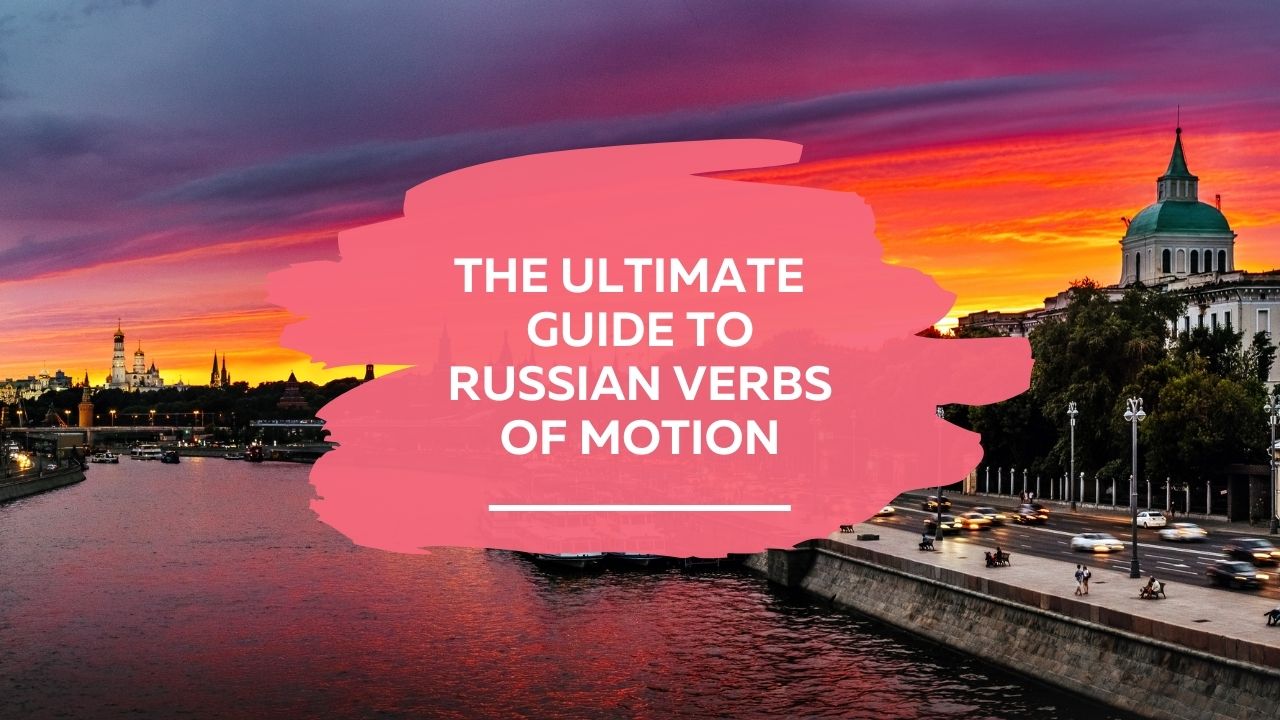
Anyone who learns Russian will agree that it’s a tricky language and Russian verbs of motion are definitely part of that challenge.
That's on top of other verb issues like verb conjugation according to person and number and two distinct time aspects you’ll also need to get familiar with. Wow.
In English, verbs of motion are our words like running, walking, jogging, climbing, driving, and travelling. In the Russian language, the verbs of motion (глаголы движения) are an important group.
And while the Russian verbs of motion may seem complex at first, they just take a bit of explanation to master. As such, this article is going to give you a detailed overview of Russian verbs of motion including when to use them, the different forms, and the most important verbs to know.
In this post, you'll learn:
- What unidirectional verbs are
- What multidirectional verbs are
- The most common verbs of motion
- A list of all 14 verbs of motion
- The common prefixes used with Russian verbs of motion
- Aspect for verbs of motion in Russian
By the way, if you want to learn Russian fast and have fun, my top recommendation is Russian Uncovered which teaches you through StoryLearning®.
With Russian Uncovered you’ll use my unique StoryLearning® method to learn Russian through story… not rules. It’s as fun as it is effective. If you’re ready to get started, click here for a 7-day FREE trial.
Part One – The Basics Of Verbs Of Motion

Going From Point A To B
If we want to talk about movement in English, most of the time you can use the word “go/went” and that works just fine. Consider how all these sentences use the same word.
- I went to China, I went to the store, I went to school
When you see the word “went” in these sentences, we know that movement happened. However, this doesn’t tell us much information about the trip or how it was done. So we don’t know if someone goes on foot, on a bike, or by train. This is how Russian is different.
Unlike English, Russian has no singular word you can use to mean “go”. With Russian verbs of motion, you have to be more specific about how a trip happens. That means that you have to clarify two things.
- Whether someone is going and coming back or someone is going for a single, one time trip .
- How that movement occurs.
How You Move Matters In Russian
In Russian, verbs of motion aren’t interchangeable. You have to take into account the specific way how someone or something moves.
We’ll start with the two verb pairs that you’ll use and see the most: идти/ходить and ехать/ездить.
Here’s a conjugation table:
| Я | ты | он/она | мы | вы | они | ||
| Идти | иду | идёшь | идёт | идём | идёте | идут | |
| Ходить | хожу | ходишь | ходит | ходим | ходите | ходят | |
| Ехать | еду | едешь | едет | едем | едете | едут | |
| Ездить | езжу | ездишь | ездит | ездим | ездите | ездят |
You can translate all four of these verbs into the English term “go” but these two different sets refer to how you arrive somewhere. The pair идти/ходить is for moving somewhere by foot.
On the other hand, ехать/ездить should be used for going by any kind of vehicle. This is regardless of who’s driving.
You can use the verb ехать or ездить by itself or you can specify the mode of travel with a noun in the prepositional case.
| Ездить | to go, to travel |
| Ездить на машине | to go by car |
| Ездить на поезде | to go by train |
| Ездить на лошади | to go by horse |
Directional Verbs
While expressing how you move is required, so is stating the direction you move in. In Russian, there are two kinds of verbs of motion: unidirectional and multidirectional.
Don’t get put off by the terminology because I’ll explain each of them in detail.
Multidirectional Verbs

As the name implies, multidirectional verbs express movement in more than one direction. Often this can refer to a trip to a location and back. But it also describes moving around, back and forth, side to side or any other movement in various directions.
In other words, if the subject is moving with more than a single (often defined) endpoint, then you’ll probably use these verbs.
To sum up, you should use multidirectional verbs to describe:
- general habits and regular trips
- moving in several directions
- ability
- habit
- movement with returning
Regular Action
Any habitual or recurring action will use this form.
- Каждый день он ходит в школу (Every day he walks to school)
- Дедушка ходит с палкой (Grandpa walks with a cane)
If you have an adverb of time like часто (often), обычно (usually), or всегда (always) then it usually pairs with the multidirectional verb.
- Мы часто ходим в кино (We often go to the movies)
Various directions
- Они ходили по городу (They walked around the city)
- Мы ездили по стране (We traveled around the country)
- Ты ездила по кругу (You were driving in circles)
Travelling around an area will often use the preposition по and a noun in the dative case.
Ability
- Я могу ездить туда (I can go there (by vehicle)/I can drive there)
Return Trips
When a multidirectional verb is put in the past tense, it describes a journey to somewhere as well as a return
- Я ездила в университет (I went (by vehicle) to the university)
(and also returned)
- Папа ходил в киоск (Papa walked to the kiosk)
(and came back)
Unidirectional Verbs In Russian

While we use ездить and ходить to describe moving in multiple directions, unidirectional verbs (ехать and идти) have a more narrow meaning. As the name suggests, you should use these verbs when talking about one specific direction or trip.
You should use unidirectional verbs to describe movement:
- with a named goal or destination
- towards a particular direction
- where another action occurs
- in progress
Moving With A Goal Or Direction
- Мы едем в Псков (We are going/driving to Pskov)
- Мы идём к заливу (We’re walking towards the bay)
Unidirectional verbs can also describe a habit, if it has a specified end destination.
- Обычно я иду на работу, и еду домой на автобусе. (Usually I walk to work, and I ride the bus home)
- Весной журавли летят на север (In the spring the cranes go north)
Movement In Progress
Often unidirectional verbs describe a movement that is (or was ) in progress. This has a sense of happening in the moment.
- Я еду в магазин (I’m driving to the store (currently))
- Я иду в магазин (I’m walking to the store (currently))
Event During Movement
If something happens while someone is going somewhere, then you most often use the unidirectional verb.
- Когда я шел в киоск, потерял бумажник (When I was walking to the kiosk, I lost my wallet)
- Мне позвонил Виктор, когда я ехала сюда (I got a call from Viktor when I was driving here)
Common Uses Of The Verb идти

Aside from its meaning “to go on foot” the verb идти has a number of uses to describe other situations. Often these have a more metaphorical sense of the word “go”. These include activities in progress, fitting, and expressions describing weather.
Weather
- идёт дождь/снег/ град (it’s raining, snowing, hailing)
Events Or Activities In Progress
- идёт фильм (there’s a film playing)
- идёт урок (there’s a lesson happening)
Other Meanings
- Идут часы (the clock is working)
- Все идёт по плану (everything is going according to plan)
- Этот пиджак идёт вам (that sports jacket suites you)

Understanding The Two Kinds Of Verbs
Now that you understand the two forms that verbs of motion can come in, let’s go into a bit more detail. Although the difference may seem complex, we can actually make similar distinctions in English when talking about movement.
Let’s look at a basic example.
- Куда ты идёшь?
- Куда ты ходишь?
Both of these sentences ask the listener where they are going, but they have different nuances.
- Куда ты идёшь?
This means “where are you going?” and is asking about the present moment.
- Куда ты ходишь?
You can think of this question more as “Where do you go?” This phrase is asking about habit or recurring action.
So to reiterate the point Russian has two kinds of verbs of motion. Unidirectional verbs (like идти and ехать) are used for one-time, one direction movements. Multidirectional verbs (ходить and ездить) describe regular, and movements somewhere and back.

Part Two – Other Verbs Of Motion In Russian
Up till this point, we’ve only discussed the verb pairs идти/ходить and ехать/ездить. In total, there are 14 pairs for verbs of motion. That means you’ll only have to learn this list and you’ll know all the Russian verbs of motion.
The 14 Russian Verbs Of Motion
| One direction | Multidirectional | Translation |
| Идти | ходить | to go (on foot) |
| Ехать | ездить | to go, to drive |
| Бежать | бегать | to run |
| лететь | летать | to fly |
| Плыть | плавать | to swim |
| Лезть | лазить | to climb |
| Ползти | ползать | to crawl |
| Брести | бродить | to wander, to roam |
| нести | носить | to carry, to bring |
| вести | водить | to lead |
| Везти | возить | to carry, to transport (by vehicle) |
| Гнать | гонять | to drive, to chase (cattle or animals) |
| Катить | катать | to drive, to ride, to roll |
| Тащить | таскать | to drag |
The first eight verbs on this list are intransitive and don’t take any direct object. Here are some examples of these verbs.
- Знаю куда он бежит (I know where he’s running to)
- Птичка летала (The little bird flies)
- Рыба плавает (The fish swims)
- Она бродила по лесу (She was wandering through the forest)
- Карапуз ползёт по полу (The toddler is crawling on the floor)
- Она отлично лазит (She climbs excellently)
The last six verb pairs on the list can take direct objects. These will take on the accusative case.
- Фермеры гоняли скот туда (The farmers drove the cattle)
- Ты тащила меня через город (You dragged me across the city)
- Она катит коляску (She’s pushing the stroller)
Carrying Creates Motion
The verb pairs нести/носить and вести/водить all have meanings that are similar to “to carry”, “to take” or “to bring”.
However they are different in what’s being transported and how. And while the verb взять/брать can also mean “to take”, these verbs indicate that something is changing its location.
нести/носить means to take or carry something on foot
вести/водить means to take or carry a person or animal
везти/возить means to take or carry something by vehicle
- Мама несла книги в школу (Mama took/brought the books to school)
- Папа вёл детей в школу (Papa took/brought the children to school)
- Судно везло продукты (The ship brought/transported the products)
These verbs also have a number of metaphorical meanings that are commonly used. You might already be familiar with how носить is used to talking about wearing clothes or shoes.
- Вести переписку (to keep/carry on a correspondence)
- Вести войну (to wage war)
- Нести наказание (to bear/undergo punishment)
- Носить одежду, обувь (to wear clothes, shoes)

Part Three – Prefixes With Verbs Of Motion
Now that you’ve learned about the fourteen different verbs of motion, you can take things further by adding prefixes onto them.
These include prefixes that give grammatical information as well as ones that tell you about how the action is completed.
The Most Common Prefixes
With prefixes you can describe motion with more specificity. In English, we add this kind of detail by using prepositions after the verb.
Most of the prefixes listed below should look familiar. There are other prefixes that can be added on as well, but let’s start with these, since they are the most common.
- в- (in, into)
- вы- (out)
- до- (as far as, up to)
- об- (around)
- от- (away)
- пере- (across, through)
- под- (approaching)
- при- (at (arrival))
- про- (up to)
- с- (down from, away from)
- у- (away from)
For the majority of verbs, adding these prefixes is simple. However, you should know that for the verb идти, the verb stem will change to -йти.
Prefixed Verbs Plus Prepositions
Most of these prefixed verbs will also require a preposition before the location. Some verbs will use different prepositions depending on that situation, meaning, or the noun that follows. Let’s look at a few examples to get a better idea.
| Входить/войти | в магазин | to go into the store |
| Выходить/выйти | из магазина | to go out of the store |
| доходить/дойти | до магазина | to go up to the store |
| обходить/обойти | магазин | to go around the store |
| отходить/отойти | от магазина | to go away from the store |
| переходить/перейти | улицу | to go across the street |
| переходить/перейти | через город | to go through the city |
| Подходить/подойти | к магазину | to come up to the store |
| Приходить/прийти | к магазину | to arrive at the store |
| сойти | с поезда | to go down from the store |
| Уходить/уйти | из магазина | to leave the store (place) |
| Уходить/уйти | от Анны | to leave Anna (person) |
An Example
As such you could say something like…
Борис переходил улицу, пришел к магазину, обошёл магазин, вошел в магазин и через 5 минут ушел из магазинА (Boris went across the street (with the intention of returning), he arrived at the store, walked around the store (outside it), went into the store, and after 5 minutes, left the store.)
Of course all Russian verbs of motion can be combined with different prefixes. These will help you express specific motions.
- Мы выбегаем из моря (We run out of the sea)
- Автобус подъезжает к базе (The bus drives up to the base)
- Она перелезла через забор (she climbed over the fence)
- Он привел тебе матроса (He brought you the sailor/He brought the sailor to you)
- Катя перенесла книгу (Katya brought the book over)
The Prefix ПО- In Verbs Of Motion

Another prefix for Russian verbs of motion is по-. You may recognize this as the prefix that many verb pairs use to distinguish between perfective and imperfective aspects, such as смотреть/посмотреть (to watch) and кушать/покушать (to have a meal).
Adding this prefix will create the perfective aspect for both unidirectional and multidirectional verbs. That means that any verb of motion that starts with the prefix по- is describing a fully completed action.
| пойти | походить | to go (on foot) |
| поехать | поездить | to go, to drive |
| побежать | побегать | to run |
| полеТеть | полетать | to fly |
| поплыть | поплавать | to swim |
| полезть | полазить | to climb |
| поПолзти | поползать | to crawl |
| побрести | побродить | to wander, to roam |
| понести | поносить | to carry, to bring |
| повести | поводить | to lead |
| повезти | повозить | to carry, to transport (by vehicle) |
| погнать | погонять | to drive, to chase (cattle or animals) |
| покатить | покатать | to drive, to ride, to roll |
| потащить | потаскать | to drag |
The Perfective Aspect With Unidirectional Verbs
The perfective form of unidirectional verbs expresses the start of a movement or start of a journey.
- Они поехали за границу (they have set out abroad)
- Моя сестра полетела в Китай (My sister flew to China (she hasn’t returned yet))
- Ребенок пошел с 9 месяцев (The baby started to walk at 9 months)
It can also describe a new or changing action
- Я шел по лесу, потом побежал (I was walking through the woods and then broke into a run)
- Мы шли медленно, потом пошли быстрее (We were walking slowly, and then started walking faster)

The Perfective Aspect With Multidirectional Verbs
The perfective aspect of multidirectional verbs expresses an action that’s short and/or has been completed.
- Они походили по городу (They walked around the city a bit)
(for a little while)
- Он много поездил по Европе (He travelled a lot around Europe)
(the action is completed)
While the combination of aspect and direction may be confusing at first, there are some simple rules to follow so you know which is which.
Imperfective Aspect
- Verbs of motion without prefixes
- Multidirectional verbs with prefixes
Perfective Aspect
- Unidirectional verbs with prefixes
- Unidirectional verbs with the prefix по-
- Multidirectional verbs with the prefix по-
Likewise, the context of a phrase should help you understand whether an action is complete as well.
Moving Forward With Learning Russian

Let's be honest – verbs of motion are one of the hardest parts of Russian grammar. But don't let the grammar villain get you down!
While it may seem like a lot at first, if you keep working on it and practicing Russian with a fun and effective method, like StoryLearning®, you’ll be talking about going here, there, and everywhere without a second thought.
So look out for these Russian verbs of motion as you immerse yourself daily in the Russian language, whether that's by reading short stories in Russian or watching Russian movies on Netflix.
My intention with this article was to demystify Russian verbs of motion. And now that you've gotten to the end, you should know a lot more about:
- Unidirectional verbs
- Multidirectional verbs
- The difference between them
- The most common verbs of motion
- Russian’s fourteen verbs of motion
- The most used prefixes for Russian verbs of motion
- Time aspect for all verbs of motion
Hope you found the information helpful. And as always Удача из удач! (Best of luck!)

Olly Richards
Creator of the StoryLearning® Method
Olly Richards is a renowned polyglot and language learning expert with over 15 years of experience teaching millions through his innovative StoryLearning® method. He is the creator of StoryLearning, one of the world's largest language learning blogs with 500,000+ monthly readers.
Olly has authored 30+ language learning books and courses, including the bestselling "Short Stories" series published by Teach Yourself.
When not developing new teaching methods, Richards practices what he preaches—he speaks 8 languages fluently and continues learning new ones through his own methodology.









































